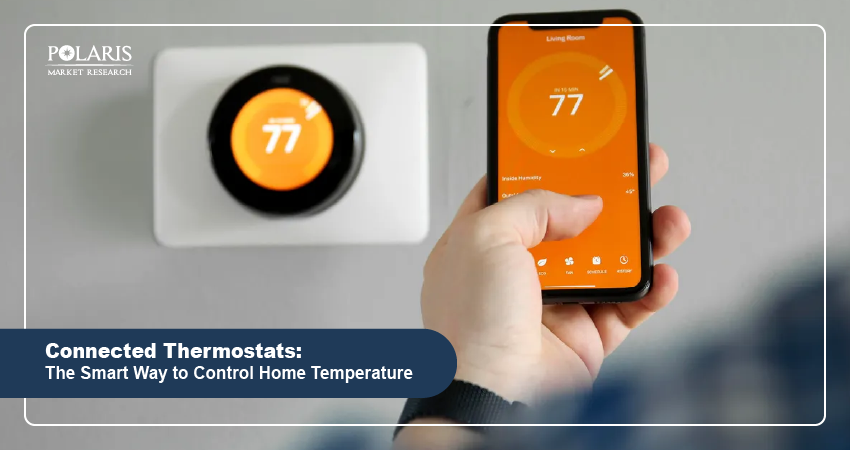Connected Thermostats: The Smart Way to Control Home Temperature

In today’s technology-driven world, smart homes and devices have become a key aspect of modern living. Among these various innovations transforming modern living are connected thermostats. In addition to enhancing convenience, connected thermostats significantly contribute to energy efficiency and cost savings.
In this blog post, we take you to the realm of connected thermostats, exploring their basics and working principles. Additionally, we shed light on the current state of the connected thermostat market and the key factors propelling the market forward. Read on!
What Is A Connected Thermostat?
A connected thermostat, also referred to as a smart thermostat, is a device that connects to the Internet. It enables users to program and control the cooling and heating temperature in their homes. Connected thermostats can be managed by other smart devices, including smartphones and tablets. A key feature of these thermostats is their automatic adjustment, allowing users to maintain optimal comfort conditions.
Connected thermostats can make temperature adjustments based on various factors, including set points, user schedules, and occupancy. Advanced thermostats have the capability to configure the operations of specific units based on weather conditions.
How Do Connected Thermostats Work?
The working of connected thermostats may differ from one manufacturer to another. But the one thing they all have in common is that they are designed to be connected to the Internet. So, just like smart home automation systems, having a reliable Internet connected is important to ensure seamless operation of the thermostat.
Connected thermostats communicate with the cooling and heating equipment in a manner similar to a traditional thermostat. The main difference lies in how they communicate with the user. This is particularly true when the thermostat is controlled via a mobile app. These apps enable quick and easy creation of heating and cooling schedules. That way, users are more likely to use this energy-saving feature. Additionally, mobile apps facilities easy controlling of the thermostat from anywhere.
With connected thermostats, users have the option to make thermostat adjustments with a few taps while they’re away from home. Many thermostats come with advanced features, such as the ability to adapt to the user’s habits and schedules. Furthermore, some connected thermostats leverage geofencing technology for recognizing when the user is moving close to the home so that they have optimal conditions upon arrival.
What Are Major Market Metrics?
Our latest analysis reveals the connected thermostat market to register sustained growth. The market is projected to reach USD 9.74 billion by 2034, exhibiting a CAGR of 14.7% between 2025 and 2034.
The rapid adoption of smart home technologies is driving demand for connected thermostats. Additionally, growing focus on energy efficiency is prompting individuals to invest in connected thermostats, as they offer intelligent control over HVAC systems.
What Is the Installation Procedure for A Connected Thermostat?
Installing a connected thermostat is easier than most individuals think. Of course, individuals can always have a technician do the installation for them. But for users who are technically inclined and have the right tools in their arsenal, here are the installation steps:
Turn Off Power
The first step in installing a connected thermostat is switching off the power to the existing thermostat and the HVAC system. The circuit breaker in the main service panel typically comes with labels, so it’s easy for users to spot the switch for turning off the power. It’s important to note that thermostats shouldn’t be installed on circuits that exceed the manufacturer-specific voltage. This is because doing so may damage the control and also pose safety risks and fire hazards.
Take Away the Old Thermostat
Users will need a screwdriver to remove the cover plate, which is used for securing the thermostat. Before taking out the thermostat, it’s recommended to label the wires. This is because it makes it easy for users to identify which terminals they connect to later on.
Disconnect the Wires
The terminal can now be safely disconnected from the wires. It’s advised to tape the wires to the walls so that they can be kept out of the way. Additionally, taping the wires means they can be prevented from falling into the wall.
Check for a C-Wire
The C-wire is responsible for providing power to the thermostat. In some instances, the C-wire may get tucked behind the wall or plate. In the HVAC control board, users will find a wire connected to the C terminal if the C-wire is already present. If in case the wire can’t be spotted, users can consider going with an “add-a-wire” kit or a power extender kit.
Install the Connected Thermostat
If the C-wire is present, users can follow the manufacturer’s instructions to ensure that every step is being followed. However, in general, users will need to separate the new thermostat’s front and base, ensure the thermostat is level, attach the thermostat base to the wall, connect the wires to the matching terminals, and tighten any loose wire connections.
What Are Benefits of Connected Thermostats?
There are several benefits associated with using thermostats offered by connected thermostat market key players. The first is their ability to significantly reduce the consumption of energy. Studies show that connected thermostats can help users save between 15% and 25% on cooling and heating costs.
Second, the integration of mobile apps allows for seamless control. For example, the user-friendly interface and advanced features of connected thermostats enable users to make temperature adjustments with just a few taps on their smart device.
Third, connected thermostats enable easy integration with the current smart home ecosystem. These thermostats ensure that the home’s temperature control system works harmoniously with other smart home appliances, improving overall efficiency and convenience.
To Conclude
The connected thermostat market offers innovative solutions for smart homes. They offer significant benefits in terms of energy savings and improved comfort. As technology advances, manufacturers are expected to introduce increasingly advanced thermostats with improved features in the years to come.

